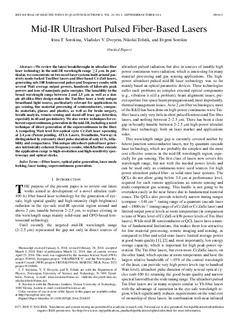Mid-IR ultrashort pulsed fiber-based lasers
| dc.contributor.author | Sorokina, Irina T | |
| dc.contributor.author | Dvoyrin, Vladislav | |
| dc.contributor.author | Tolstik, Nikolai | |
| dc.contributor.author | Sorokin, Evgeni | |
| dc.date.accessioned | 2017-11-07T09:45:55Z | |
| dc.date.available | 2017-11-07T09:45:55Z | |
| dc.date.created | 2015-01-29T23:35:24Z | |
| dc.date.issued | 2014 | |
| dc.identifier.issn | 1077-260X | |
| dc.identifier.uri | http://hdl.handle.net/11250/2464520 | |
| dc.description.abstract | We review the latest breakthroughs in ultrafast fiber laser technology in the mid-IR wavelength range ≥2 μm. In particular, we concentrate on two novel laser systems built around passively mode-locked Tm:fiber lasers and fiber-based Cr:ZnS lasers, generating sub-100 femtosecond pulses and frequency combs with several Watt average output powers, hundreds of kilowatts peak powers and tens of nanojoule pulse energies. The tunability in the broad wavelength range between 2 and 2.5 μm as well as a simple all-silica-fiber design makes the Tm-fiber laser a truly unique broadband light source, particularly relevant for applications in gas sensing, fine material processing of semiconductors, composite materials, glasses and plastics, as well as for brain surgery, breath analysis, remote sensing and stand-off trace gas detection, especially in oil and gas industry. We also review techniques for coherent supercontinuum generation in the mid-IR, including a novel technique of direct generation of the supercontinuum in the fiber. A competing Watt level few-optical cycle Cr:ZnS laser operating at 2.4 μm (Patent pending, ATLA Lasers, Trondheim, Norway) is distinguished by extremely short pulse duration of only 41 fs, reliability and compactness. This unique ultrashort-pulsed laser generates intrinsically coherent frequency combs, which further extends the application range to high-resolution and high-sensitivity spectroscopy and optical clocks. | nb_NO |
| dc.language.iso | eng | nb_NO |
| dc.publisher | Institute of Electrical and Electronics Engineers (IEEE) | nb_NO |
| dc.title | Mid-IR ultrashort pulsed fiber-based lasers | nb_NO |
| dc.type | Journal article | nb_NO |
| dc.type | Peer reviewed | nb_NO |
| dc.description.version | publishedVersion | nb_NO |
| dc.source.volume | 20:0903412 | nb_NO |
| dc.source.journal | IEEE Journal of Selected Topics in Quantum Electronics | nb_NO |
| dc.source.issue | 5 | nb_NO |
| dc.identifier.doi | 10.1109/JSTQE.2014.2310655 | |
| dc.identifier.cristin | 1211902 | |
| dc.relation.project | Norges forskningsråd: 219686 | nb_NO |
| dc.relation.project | Norges forskningsråd: 191614 | nb_NO |
| dc.description.localcode | © 2014 IEEE. Translations and content mining are permitted for academic research only. Personal use is also permitted, but republication/redistribution requires IEEE permission. | nb_NO |
| cristin.unitcode | 194,66,20,0 | |
| cristin.unitname | Institutt for fysikk | |
| cristin.ispublished | true | |
| cristin.fulltext | postprint | |
| cristin.qualitycode | 2 |
Tilhørende fil(er)
Denne innførselen finnes i følgende samling(er)
-
Institutt for fysikk [2703]
-
Publikasjoner fra CRIStin - NTNU [38484]
